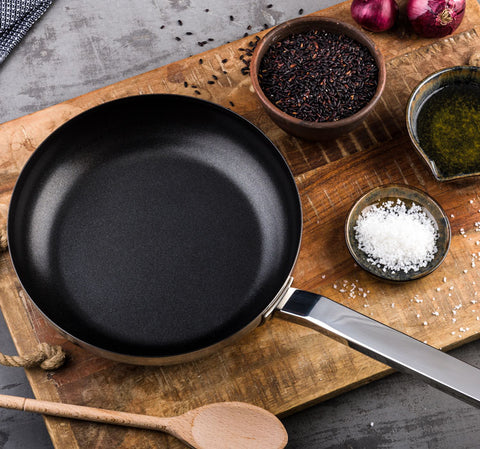Buying Guide
Stainless Steel vs. Nonstick Cookware: Which is Best for You?
Choose the right pots and pans for your cooking needs
Whether you are buying cookware for the first time, upgrading or adding to your existing cookware, or buying a specialty pot for a specific recipe, you will need to purchase cookware that is durable, efficient, and the right equipment for the job. When selecting cookware, should you purchase stainless steel or nonstick? If you like to cook, the answer is both. Each type has both benefits and drawbacks, and having both stainless and nonstick pots and pans in your kitchen ensures you have the cookware you need for any task. Correctly using the right cookware for the dishes that you are preparing will make the equipment last longer and improve your cooking skills.

Stainless Steel Cookware
Durable and easy to clean, stainless steel cookware is the workhorse used by professional chefs and home cooks. To provide more even heat conduction, higher-quality, multi-ply pots and pans typically have an aluminum or copper core between the layers of stainless steel. Stainless steel is the go-to material in cookware, because it is reliable, long-lasting, sears and browns meats better than nonstick, and is dishwasher safe for easy cleanup. Plus, you won’t have worry about your cookware rusting or losing its coating. Stainless steel cookware can handle any cooking task such as frying, braising, poaching, blanching, and simmering to cook any food you want to make. Stock up on a variety of stainless steel cookware including saucepans, sauté pans, braiser pans, frying pans, Dutch ovens, and stock pots.
Pros of stainless steel
- Durable and rust-resistant
- Has no coating that wears over time
- Sears and browns meats well
- Oven safe at high temperatures
- Safe to use with metal utensils
- Great for frying and sautéing
- Non-reactive with acidic foods such as tomatoes or wines
- Can be nonstick when oiled and heated properly
- Will last a lifetime
Cons of stainless steel
- Requires more attention and care to prevent foods from burning or sticking
- Must be oiled and heated when frying and sautéing
- Might require scrubbing if handwashing
- Not ideal for delicate foods such as eggs or crepes that are prone to sticking
- More expensive than nonstick cookware
Nonstick Cookware
Nonstick cookware usually has a heat-conductive aluminum core and it coated with a material such as ceramic or Teflon to create a nonstick interior that easily releases food. While typically lighter in weight than stainless steel, you should choose a pan with a thicker bottom that will more evenly distribute heat. Some nonstick cookware is oven-friendly, but should not be heated over 400 degrees F as higher temperatures can damage the coating. Always use silicone, nylon, or wood utensils with nonstick cookware to avoid scratching the interior coating. Handwashing is recommended, since nonstick cookware can be damaged by the heat and abrasive cleaners used in dishwashers.
Benefits of nonstick cookware
The obvious advantage to nonstick cookware is that it prevents food from sticking to the pan. Nonstick fry pans and sauté pans are the perfect choice for cooking foods that have a tendency to stick such as eggs, omelets, crepes, pancakes, fish, tofu, and other delicate foods. It is not recommended for cooking in higher temperatures and will not provide a good sear when browning meats. High-quality nonstick cookware is easy to use and cleans up easily though it is not dishwasher safe. It’s easier for beginner chefs to use, and is more affordable than stainless steel cookware.
Pros of nonstick cookware
- Prevents food from sticking to the pan
- Ideal for cooking delicate foods such as eggs, fish, and tofu
- Cooks using less oil or butter
- Fast cleanup without scrubbing
- Convenient and easy to use for beginner chefs
- More affordable than stainless steel
Cons of nonstick cookware
- Less durable than stainless steel; coating can chip
- Cannot use metal utensils; silicone, nylon, or wood only to prevent scratching
- Not as high resistant; requires medium or low cooking temperature
- Not recommended for use with acidic foods which can damage the coating
- Not always oven safe
- Not dishwasher safe
- Won’t last a lifetime; the coating will wear and stop working over time
If you love cooking, you’ll want to own a selection of both stainless steel and nonstick cookware to get the best of both worlds in durability and ease of use. Use stainless steel for most of your cooking needs, and save the nonstick for scrambling or frying eggs, making an omelet, or whipping up stacks of pancakes in the morning.











